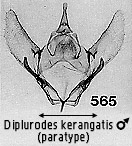|
Diplurodes kerangatis sp. n.

Diplurodes kerangatis ♂
(paratype) |
 |
♂♀
11-13mm. This species is very similar to D. sugillata but may be
distinguished by the browner tinge to the grey suffusion, a suffusion that
usually obscures the medial zone of the forewing. The postmedial fasciae are
less dentate, more sinuous in course. The male genitalia have a slender,
spatulate uncus and no tongue from the tegumen. The valves are trapezoid with a
single, large, digitate process at the sacculus that lies close to the ventral
margin and is slightly upcurved at the apex.
Holotype ♂. BRUNEI: Ulu Temburong,
LP283, 350m (T. W. Harman), BM geometrid slide 15861.
Paratypes: 1♂ BRUNEI: 300m Ulu
Temburong, rainforest, 24.4.81 (Lt.
Col. M.G. Allen) BM geometrid slide 13185; 23 examples SARAWAK: Gunung Mulu
Nat. Park, R.G.S Exped. 1977-8 (J.D. Holloway et al.) Mulu, various
localities (see below). BM geometrid slides (♂♂) 10438, 10442, 10446.
Geographical range. Borneo, Sumatra, Peninsular Malaysia.
Habitat preference. Most of the specimens were taken during the Mulu
survey in wet heath forest (kerangas) on raised river terraces in the lowlands.
A few are from hill dipterocarp forest, and there are records also from lower
montane forest on G. Mulu and the limestone G. Api.
<<Back
>>Forward <<Return
to Contents page
|

